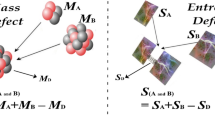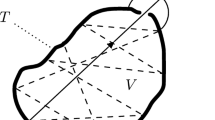Abstract
The relativistic velocity composition paradox of Mocanu and its resolution are presented. The paradox, which rests on the bizarre and counterintuitive non-communtativity of the relativistic velocity composition operation, when applied to noncollinear admissible velocities, led Mocanu to claim that there are “some difficulties within the framework of relativistic electrodynamics.” The paradox is resolved in this article by means of the Thomas rotation, shedding light on the role played by composite velocities in special relativity, as opposed to the role they play in Galilean relativity.
Similar content being viewed by others
References and notes
Constantin I. Mocanu, “Some difficulties within the framework of relativistic electrodynamics,”Arch. Elektrotech. 69, 97–110 (1986).
R. P. Feynman, R. B. Leighton, and M. Sands,The Feynman Lectures on Physics (Addison-Wesley, Reading, Massachusetts 1964), Vol. II, Sec. 17-4.
G. P. Sastry, ‘Is length contraction really paradoxical?”Am. J. Phys. 55, 943–945 (1987).
Constantin I. Mocanu,Electrodynamics of Moving Bodies at Relativistic Velocities (Publ. House of Roum. Acad., Bucharest, 1985); “Hertzian alternative to special theory of relativity. I. Qualitative analysis of Maxwell's equations for motionless media,”Hadronic J. 10, 61–74 (1987), and references therein.
L. H. Thomas, “The motion of the spinning electron,”Nature (London) 117, 514 (1926); “The kinematics of an electron with an axis,”Philos. Mag. 3, 1–22 (1927); see also Ref. 28.
George E. Uhlenbeck, “Fifty years of spin: Personal Reminiscences,”Phys. Today 29, 43–48 (June, 1976).
Presently, most books on STR make no mention of the Thomas rotation (or precession). Several outstanding exceptions are: E. F. Taylor and J. A. Wheeler,Spacetime Physics, H. M. Foley and M. A. Ruderman, eds. (Freeman, San Francisco, 1966); M. C. Møller,The Theory of Relativity (Clarendon Press, Oxford, 1952); J. D. Jackson,Classical Electrodynamics (Wiley, New York, 1975); and H. P. Robertson and T. W. Noonan,Relativity and Cosmology (Saunders, Philadelphia, 1968). Several articles on the Thomas precession (rotation) are listed in Refs. 8–22.
Lanfranco Belloni and Cesare Reina, “Sommerfeld's way to the Thomas precession,”Eur. J. Phys. 7, 55–61 (1986).
Ari Ben-Menahem, “Wigner's rotation revisited,”Am. J. Phys. 53, 62–66 (1985). In this article, as well as in several others, the Thomas rotation is referred to as theWigner rotation. The use of the term “Wigner rotation” for the description of the Thomas rotation apparently came into the English literature from a text by S. Gasiorowicz,Elementary Particle Physics (Wiley, New York, 1967), p. 74, who copied the term from the German literature. An objection to the use of this term for the description of the Thomas rotation is based on the claim that the “correct” Wigner rotation is the Thomas rotation measured in the frame in which the accelerated particle is at rest; see Ref. 25 of Ref. 28.
Shahar Ben-Menahem, “The Thomas precession and velocity space curvature,”J. Math. Phys. 27, 1284–1286 (1986).
James T. Cushing, “Vector Lorentz transformations,”Am. J. Phys. 35, 858–862 (1967).
Sidney Dancoff and D. R. Inglis, “On the Thomas precession of accelerated axes,”Phys. Rev. 50, 784 (1936).
S. F. Farago, “Derivation of the spin-orbit interaction,”Am. J. Phys. 35, 246–249 (1967). This article containes an incorrect statement about the Thomas rotation, see Ref. 17 of Ref. 28;
George P. Fisher, “The electric dipole moment of a moving magnetic dipole,”Am. J. Phys. 39, 1528–1533 (1971) and “The Thomas precession,”40, 1772–1781 (1972).
W. H. Furry “Lorentz transformation and the Thomas precession,”Am. J. Phys. 23, 517–525 (1955).
Roger R. Haar and Lorenzo J. Curtis, “The Thomas precession givesg e - 1, notg e /2,”Am. J. Phys. 55, 1044–1045 (1987).
A. C. Hirshfeld and F. Metzger, “A simple formula for combining rotations and Lorentz boots,”Am. J. Phys. 54, 550–552 (1986).
K. R. MacKenzie “Thomas precession and the clock paradox,”Am. J. Phys. 40, 1661–1663 (1972).
E. G. Peter Rowe “The Thomas precession,”Eur. J. Phys. 5, 40–45 (1984).
Nikos Salingaros “The Lorentz group and the Thomas precession. II. Exact results for the product of two boosts,”J. Math. Phys. 27, 157–162 (1986); and “Erratum: The Lorentz group and the Thomas precession. II. Exact results for the product of two boosts,”J. Math. Phys. 29, 1265 (1988).
David Shelupsky, “Derivation of the Thomas precession formula,”Am. J. Phys. 35, 650–651 (1967).
N. W. P. Strandberg, “Special relativity completed: The source of some 2s in the magnitude of physical phenomena,”Am. J. Phys. 54, 321–331 (1986).
L. H. Thomas, “Recollections of the discovery of the Thomas precessional frequency,” AIP Conf. Proc. No. 95, High Energy Spin Physics, G. M. Bunce, ed. (Brookhaven National Lab, 1982), pp. 4–12.
See, for instance, V. B. Berestetskii, E. M. Lifshitz, and L. P. Pitaevskii,Quantum Electrodynamics, trans. by J. B. Sykes and J. S. Bell (Pergamon Press, New York, 1982), p. 126.
See, for instance, J. T. Cushing. “
Albert Einstein, “Zur Elektrodynamik Bewegter Körper (On the Electrodynamics of Moving Bodies),”Ann. Phys. 17, 891–921 (1905). For English translation, see H. M. Schwartz “Einstein's first paper on relativity” (covers the first of the two parts of Einstein's paper),Am. J. Phys. 45, 18–25 (1977); and H. A. Lorentz, A. Einstein, H. Minkowski, and H. Weyl,The Principle of Relativity, trans. by W. Perrett and G. B. Jeffery, (Dover, New York) 1952), first published in 1923.
A. A. Ungar, “Thomas rotation and the parametrization of the Lorentz transformation group,”Found. Phys. Lett. 1, 57–89 (1988).
A. A. Ungar, “The Thomas rotation formalism underlying a nonassociative group structure for relativistic velocities,”Appl. Math. Lett. 1, 403–405 (1988).
A. A. Ungar, “The relativistic noncommutative nonassociative group of velocities and the Thomas rotation,”Results Math. 16, 168–179 (1989).
M. C. Møller,The Theory of Relativity (Clarendon Press, Oxford, 1952), p. 42.
A. A. Ungar, “Weakly associative groups,” preprint.
H. Wefelscheid,Proc. Edinburgh Math. Soc. 23, 9 (1980); W. Kerby and H. Wefelscheid, “The maximal sub near-field of a near-___domain,”J. Algebra 28, 319–325 (1974); H. Wähling,Theorie der Fastkörper (Thales, W. Germany, 1987), and references therein.
Author information
Authors and Affiliations
Rights and permissions
About this article
Cite this article
Ungar, A.A. The relativistic velocity composition paradox and the Thomas rotation. Found Phys 19, 1385–1396 (1989). https://doi.org/10.1007/BF00732759
Received:
Revised:
Issue Date:
DOI: https://doi.org/10.1007/BF00732759




